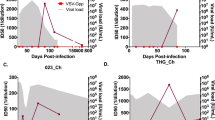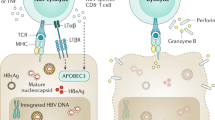Abstract
As acute hepatitis C virus (HCV) infection is clinically inapparent in most cases, the immunologic correlates of recovery are not well defined. The cellular immune response is thought to contribute to the elimination of HCV-infected cells1 and a strong HCV-specific T-helper-cell (Th) response is associated with recovery from acute hepatitis C (ref. 2). However, diagnosis of resolved hepatitis C is based at present on the detection of HCV-specific antibodies and the absence of detectable HCV RNA, and detailed comparison of the humoral and cellular immune response has been hampered by the fact that patient cohorts as well as HCV strains are usually heterogeneous and that clinical data from acute-phase and long-term follow-up after infection generally are not available. We studied a cohort of women accidentally exposed to the same HCV strain of known sequence3 and found that circulating HCV-specific antibodies were undetectable in many patients 18–20 years after recovery, whereas HCV-specific helper and cytotoxic T-cell responses with an interferon (IFN)-γ-producing (Tc1) phenotype persisted. The data indicate these HCV-specific CD4+ and CD8+ T cells are biomarkers for a prior HCV exposure and recovery. Because of undetectable antibodies against HCV, the incidence of self-limited HCV infections and recovery may be underestimated in the general population.
This is a preview of subscription content, access via your institution
Access options
Subscribe to this journal
Receive 12 print issues and online access
$209.00 per year
only $17.42 per issue
Buy this article
- Purchase on Springer Link
- Instant access to full article PDF
Prices may be subject to local taxes which are calculated during checkout



Similar content being viewed by others
References
Rehermann, B. & Chisari, F.V. Cell mediated immune response to the hepatitis C virus. Curr Top Microbiol. Immunol. 242, 299–325 (2000).
Diepolder, H.M. et al. Possible mechanism involving T lymphocyte response to non-structural protein 3 in viral clearance in acute hepatitis C virus infection. Lancet 346, 1006–1007 ( 1995).
Wiese, M. in Non-A-non-B-Hepatitis, Virushepatitis: Forschung und Praxis 146 –151, 159–162, 167 –182, 184–188, 213 –236 and 257–267 (Gustav Fischer Verlag, Jena, Stuttgart, 1991).
Ministerium für Gesundheitswesen der DDR. Bericht der Staatlichen Hygiene-Inspektion vom 26. November 1979. Deutscher Bundestag, Bundesdrucksache 13/2732 vom 24.10.1995, Bundesanzeiger Verlagsgesellschaft mbH, Bonn (1995).
Henle, W. et al. Differential reactivity of human serums with early antigens induced by Epstein-Barr virus. Science 169, 188– 190 (1970).
Cerny, A. et al. Cytotoxic T lymphocyte response to hepatitis C virus–derived peptides containing the HLA A2.1 binding motif. J. Clin. Invest. 95, 521–530 ( 1995).
Koziel, M.J. et al. Hepatitis C virus-specific cytolytic T lymphocyte and T helper cell responses in seronegative persons. J. Infect. Dis. 176,859–866 (1997).
Scognamiglio, P. et al. Presence of effector CD8+ T cells in hepatitis C virus-exposed healthy seronegative donors. J. Immunol.y 162, 6681–6689 (1999).
Rehermann, B., Ferrari, C., Pasquinelli, C. & Chisari, F.V. The Hepatitis B virus persists for decades after patients’ recovery from acute viral hepatitis despite active maintenance of a cytotoxic T-lymphocyte response. Nature Med. 2, 1104– 1108 (1996).
Chang, K.M. et al. Identification of HLA-A3 and -B7-restricted CTL response to hepatitis C virus in patients with acute and chronic hepatitis C. J. Immunol. 162, 1156–1164 (1999).
Murali-Krishna, K. et al. Persistence of memory CD8 T cells in MHC class I-deficient mice. Science 286, 1377– 1381 (1999).
Selin, L.K. & Welsh, R.M. Cytolytically active memory CTL present in lymphocytic choriomeningitis virus-immune mice after clearance of virus infection. J. Immunol. 158, 5366 –5373 (1997).
Swain, S.L., Hu, H. & Huston, G. Class II-independent generation of CD4 memory T cells from effectors. Science 286, 1381–1383 ( 1999).
Wiese, M. Thema: Virushepatitis. Der Kassenarzt 5, 36–38 (1996).
Maertens, G. et al. in Viral Hepatitis and Liver Disease (eds. Nishioka, K., Suzuki, H., Mishiro, S. & Oda, T.) 314–316 (Springer Verlag, Tokyo, 1994).
Maertens, G. et al. in Methods in Molecular Biology: Hepatitis C Protocols 11–26 (Humana Press, Totowa, New Jersey, 1999).
Rehermann, B. et al. Differential cytotoxic T lymphocyte responsiveness to the hepatitis B and C viruses in chronically infected patients. J. Virol. 70, 7092–7102 ( 1996).
Diepolder, H.M. et al. Immunodominant CD4+ T-cell epitope within nonstructural protein 3 in acute hepatitis C virus infection. J. Virol. 71 , 6011–6019 (1997).
Rehermann, B. et al. Serological pattern of hepatitis C virus recurrence after liver transplantation. J. Hepatol. 24, 15 –20 (1996).
Acknowledgements
We thank all patients who donated blood for this study; S. Bigl and L. Müller (Landesuntersuchungsanstalt, Chemnitz, Germany) for providing patient samples; T. Forsthuber (Case Western Reserve University, Cleveland, Ohio), for advice regarding the elispot technique; N. Kezmic, R. Hummes and B. Nentwig for technical assistance; and T. J. Liang and J. Hoofnagle (National Institute of Diabetes and Digestive and Kidney Diseases, National Institutes of Health) for discussion. This study was supported by grants Re1017/2-2 (Deutsche Forschungsgemeinschaft, Bonn, Germany) and 1297 (01KI 9659/5 Pathogenesis of HCV infection), Bundesministerium für Bildung, Wissenschaft, Forschung und Technologie (BMBF), Bonn, Germany, to B.R. and by grant IWT970259 (Eureka Project EU180 Hepatitits C) from the Flemish Government to Innogenetics.
Author information
Authors and Affiliations
Corresponding author
Rights and permissions
About this article
Cite this article
Takaki, A., Wiese, M., Maertens, G. et al. Cellular immune responses persist and humoral responses decrease two decades after recovery from a single-source outbreak of hepatitis C. Nat Med 6, 578–582 (2000). https://doi.org/10.1038/75063
Received:
Accepted:
Issue Date:
DOI: https://doi.org/10.1038/75063
This article is cited by
-
Mesenchymal stem cells-based therapy in liver diseases
Molecular Biomedicine (2022)
-
Antibody and Memory B Cell Responses in Hepatitis E Recovered Individuals, 1–30 Years Post Hepatitis E Virus Infection
Scientific Reports (2019)
-
Rapid decrease in titer and breadth of neutralizing anti-HCV antibodies in HIV/HCV-coinfected patients who achieved SVR
Scientific Reports (2019)
-
Characterizing hepatitis C virus epidemiology in Egypt: systematic reviews, meta-analyses, and meta-regressions
Scientific Reports (2018)
-
Hepatitis C virus infection
Nature Reviews Disease Primers (2017)



